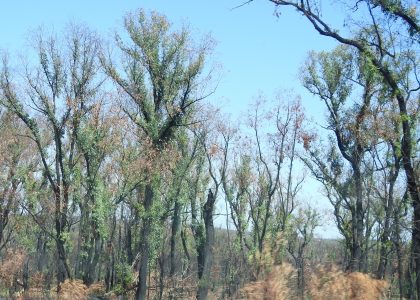Australia has always had plenty of bushfires, but recently we’ve had them more frequently more intense an earlier in the year than in most years.

Many of our dry forest plants have adaptations to fire, either bouncing back from trunks or roots, or by dropping seeds that open after heat or compound in the smoke.
How do our animals fare? Some are better able than others to hide in burrows, climb trees, or simply run, hop or fly to somewhere that is not burning. Hiding in burrows or climbing trees won’t help in the very intense fires we’ve seen lately, roaring up into the canopies an blackening everything, and some fires move so fast that even the more mobile species just can’t escape.
So it depends a lot on the type of fire and the type of animal.
After the very severe fire that demolished so much of WTA member Binna Burra, WTA donated some money to provide short-term supplementary food to some of the smaller, least mobile vertebrates of the forest floor (e.g. Antechinus, skinks, small weak-flying ground-foraging birds), and Lamington Natural History Association added to this.
We did not wish to encourage pied currawongs (one of the main predators of nesting birds) or other predators and robust competitors to stick around, so we set up experiments with motion-sensing cameras, scattering small-sized dry dog food pellets in leaf litter under dense low vegetation.
We sent the resultant report to LNHA members and other locals, and I’m reproducing it here in case it is of use to others.

Trackbacks/Pingbacks